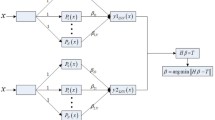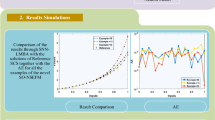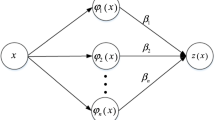Abstract
In this paper, a numerical method to solve second order nonlinear ordinary differential equations with singular initial value problems was proposed. Here, block Legendre basis neural network (B-LBNN) was developed to create approximate solution and its derivatives. We use Legendre polynomials to expand the input pattern and eliminate hidden layer. By constructing block subnetwork and transforming variables, the problem of Emden–Fowler type equations was converted to solving the algebraic equation systems. The improved extreme learning machine algorithm was used to train network weights. A series of homogeneous or nonhomogeneous Emden–fowler equations were test to validate the accuracy and efficiency of B-LBNN model. Experimental results showed that the proposed algorithm provides a new tool for this equations and can outperform other approaches in literature in terms of accuracy.












Similar content being viewed by others
References
Chandrasekhar S (1967) Introduction to the study of Stellar structure. Dover Publications, New York
Davis HT (2010) Introduction to nonlinear differential and integral equations, Dover Publications, New York
Richardson OU (1921) The emission of electricity from hot bodies, London
Wazwaz AM (2001) A new algorithm for solving differential equations of Lane-Emden type. Appl Math Comput 118:287–310
Wazwaz AM (2006) The modified decomposition method for analytic treatment of differential equations. Appl Math Comput 173:165–176
Wazwaz AM (2010) The numerical solution of special fourth-order boundary value problems by the modified decomposition method. Int J Comput Math 79(3):345–356
Bengochea G, Verde-Star L (2016) An operational approach to the Emden-Fowler equation. Math Methods Appl Sci 38(18):4630–4637
Chowdhury MSH, Hashim I (2009) Solution of Emden-Fowler equations by homotopy-perturbation method. Nonlinear Anal Real Word Appl 10:104–115
Singh OP, Pandey RK, Singh VK (2009) An analytic algorithm of Lane-Emden type equations arising in astrophysics using modified homotopy analysis method. Comput Phys Commun 180:1116–1124
Lakestani M, Saray BN (2012) Numerical solution of singular IVPs of Emden-Fowler type using Legendre scaling functions. Int J Nonlinear Sci. 13(2):211–219
Rismani AM, Monfared H (2012) Numerical solution of singular IVPs of Lane-Emden type using a modified Legendre-spectral method. Appl Math Model 36:4830–4836
Mall S, Chakraverty S (2014) Chebyshev neural network based model for solving Lane-Emden type equations. Appl Math Comput 247:100–114
Khalid M, Sultana M, Zaidi F (2014) Numerical solution of six-order differential equations arising in astrophysics by neural network. Int J Comput Appl 107(6):1–6
Zhao TG, Wu Y (2016) Numerical solution to singular ordinary differential equations of Lane-Emden type by Legendre collocation method, In: Proceedings of the 3rd international conference on material engineering and application (ICMEA 2016), Advances in Engineering Research. 103: 496–501.
Verma A, Kumar M (2020) Numerical solution of third-order Emden-Fowler type equations using artificial neural network technique. Eur Phys J Plus 135(9):1–14
Sabir Z, Baleanu D, Raja MAZ, Hincal E (2022) A hybrid computing approach to design the novel second order singular perturbed delay differential Lane-Emden model. Phys Scr 97(8):085002
Armaghani DJ, Hasanipanah M, Mahdiyar A et al (2018) Airblast prediction through a hybrid genetic algorithm -ANN model. Neural Comput Appl 29(9):619–629
Hernández-Travieso JG, Ravelo-García AG, Alonso-Hernández JB et al (2020) Neural networks fusion for temperature forecasting. Neural Comput Appl 32(20):15699–15710
Muzhou H, Taohua L, Yunlei Y (2017) A new hybrid constructive neural network method for impacting and its application on tungsten price prediction. Appl Intell 47(1):28–43
Lu X, Muzhou H, Moonho L et al (2014) A new constructive neural network method for noise processing and its application on stock market prediction. Appl Soft Comput 15:57–66
Rizk Y, Awad M (2019) On extreme learning machines in sequential and time series prediction: a non-iterative and approximate training algorithm for recurrent neural networks. Neurocomputig 345:1–19
Dwivedi AK (2018) Artificial neural network model for effective cancer classification using microarray gene expression data. Neural Comput Appl 29(12):1545–1554
Jiao Y, Pan X, Zhao Z et al (2018) Learning sparse partial differential equations for vector-valued images. Neural Comput Appl 29(11):1205–1216
Abdulla MB, Costa AL, Sousa RL (2018) Probabilistic identification of subsurface gypsum geohazards using artificial neural networks. Neural Comput Appl 29(12):1377–1391
Vargas JA, Pedrycz W, Hemerly EM (2019) Improved learning algorithm for two-layer neural networks for identification of nonlinear systems. Neurocomputing 349:86–96
Wang Y, Liu M, Bao Z et al (2019) Stacked sparse autoencoder with PCA and SVM for data-based line trip fault diagnosis in power systems. Neural Comput Appl 31(10):6719–6731
Qiao J, Zhang W (2018) Dynamic multi-objective optimization control for wastewater treatment process. Neural Comput Appl 29(11):1261–1271
Luo D, Wang JR, Shen D (2018) Learning formation control for fractional-order multi-agent systems. Math Methods Appl Sci 41:5003–5014
Luo D, Wang JR, Shen D (2019) $PD^{\alpha}$-type distributed learning control for nonlinear fractional-order multi-agent systems. Math Methods Appl Sci 42:4543–4553
Luo D, Wang JR, Shen D (2020) Consensus tracking problem for linear fractional multi-agent systems with initial state error. Nonlinear Anal Model Control 25:766–785
Si Y, Wang JR (2022) Relative controllability multi agent systems with pairwise different delays in states. Nonlinear Anal Model Control 27:289–307
Cao X, Fekan M, Shen D, Wang JR (2021) Iterative learning control for multi-agent systems with impulsive consensus tracking. Nonlinear Anal Model Control 26:130–150
Sahoo AK, Chakraverty S (2022) Machine intelligence in dynamical systems: a state-of-art review. Wiley Interdiscip Rev Data Min Knowl Discov. 12(4):e1461
Chakraverty S (ed) (2022). Springer, Germany
Sahoo AK, Chakraverty S (2021) Multilayer unsupervised symplectic artificial neural network model for solving Duffing and Van der Pol–Duffing oscillator equations arising in engineering problems, modeling and computation in vibration problems, Volume 2: Soft computing and uncertainty. IOP Publishing
Muzhou H, Xuli H (2010) Constructive approximation to multivariate function by decay RBF neural network. IEEE Trans Neural Netw 21(9):1517–1523
Muzhou H, Xuli H (2011) The multidimensional function approximation based on constructive wavelet RBF neural network. Appl Soft Comput 11(2):2173–2177
Muzhou H, Xuli H (2012) Multivariate numerical approximation using constructive L-2(R) RBF neural network. Neural Comput Appl 21(1):25–34
Huang G-B, Zhu Q-Y, Siew C-K (2006) Extreme learning machine: theory and applications. Neurocomputing 70:489–501
Hua D (2001) Matrix theory. Science Press, Beijing
Zeng X, Liang S, Hong Y, Chen J (2019) Distributed computation of linear matrix equations: an optimization perspective. IEEE Trans Autom Control 64(5):1858–1873
Liang X (2001) A recurrent neural network for nonlinear continuously differentiable optimization over a compact convex subset. IEEE Trans Neural Netw 12(6):1487–1490
Cheng L, Hou ZG, Lin Y, Tan M, Zhang WC, Wu FX (2011) Recurrent neural network for non-smooth convex optimization problems with application to the identification of genetic regulatory networks. IEEE Trans Neural Netw 22(5):714–726
Xia Z, Liu Y, Kou KI, Wang J (2022) Clifford-valued distributed optimization based on recurrent neural networks, IEEE Trans Neural Netw Learn Syst, 1–12
Cao K, Zeng X, Hong Y (2017) Continuous-time distributed algorithms for solving linear algebraic equation, In: Proceedings of the 36th Chinese Control Conference, July 26–28, Dalian, China
Acknowledgements
This work was supported by Guizhou Provincial Science and Technology Projects (No. QKHJC-ZK[2021]YB017), Guizhou Provincial Education Department Higher Education Institution Youth Science Research Projects (QJJ[2022]098), Guizhou Provincial Science and Technology Projects (No. QKHJC-ZK[2023]YB036), Hunan Province Natural Science Foundation (No. 2022JJ30673).
Author information
Authors and Affiliations
Corresponding author
Ethics declarations
Conflict of interests
The authors declare that they have no competing interests.
Additional information
Publisher's Note
Springer Nature remains neutral with regard to jurisdictional claims in published maps and institutional affiliations.
Rights and permissions
Springer Nature or its licensor (e.g. a society or other partner) holds exclusive rights to this article under a publishing agreement with the author(s) or other rightsholder(s); author self-archiving of the accepted manuscript version of this article is solely governed by the terms of such publishing agreement and applicable law.
About this article
Cite this article
Yang, Y., Wu, Y., Hou, M. et al. Solving Emden–Fowler Equations Using Improved Extreme Learning Machine Algorithm Based on Block Legendre Basis Neural Network. Neural Process Lett 55, 7135–7154 (2023). https://doi.org/10.1007/s11063-023-11254-9
Accepted:
Published:
Issue Date:
DOI: https://doi.org/10.1007/s11063-023-11254-9




